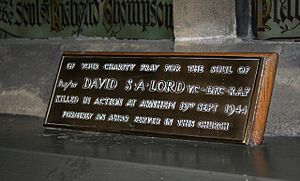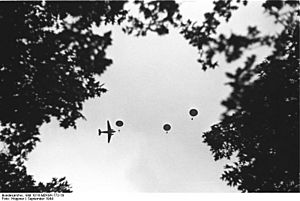David Lord (RAF officer) facts for kids
Quick facts for kids
David Lord
|
|
|---|---|
| Born | 18 October 1913 Cork, Ireland |
| Died | 19 September 1944 (aged 30) Arnhem, Netherlands |
| Buried | |
| Allegiance | United Kingdom |
| Service/ |
Royal Air Force |
| Years of service | 1936–1944 † |
| Rank | Flight lieutenant |
| Battles/wars | Second World War |
| Awards | Victoria Cross Distinguished Flying Cross Mentioned in Despatches |
David Samuel Anthony Lord was a brave pilot in the Royal Air Force during the Second World War. He was born on 18 October 1913 and sadly died on 19 September 1944. He received the Victoria Cross, which is the highest award for bravery in the face of the enemy for British and Commonwealth forces.
David Lord earned this special award for his incredible courage during the Battle of Arnhem. He was flying missions to deliver supplies to British paratroopers who were in a very tough fight. He was given the award after he died, because his actions were so heroic.
Contents
Early Life of David Lord
David Lord was born in Cork, Ireland, on 18 October 1913. His father, Samuel, was a warrant officer in the Royal Welsh Fusiliers. His mother was Mary Lord. David had two brothers.
After the First World War, his family moved to British India. David went to school there at Lucknow Convent School. Later, his family moved to Wrexham in Wales. David then studied at St Mary's College, Aberystwyth and the University of Wales.
He even went to Spain to study for the priesthood at the English College, Valladolid. But he decided that wasn't the right path for him. He returned to Wrexham and then moved to London in the 1930s. There, he worked as a writer.
Joining the Royal Air Force
David Lord joined the Royal Air Force on 6 August 1936. He worked hard and became a corporal in August 1938. He then applied to become a pilot, starting his training in October 1938.
He successfully earned his pilot's wings and became a sergeant pilot in April 1939. He was sent to No. 31 Squadron RAF in Lahore, India. He flew transport planes like the Vickers Valentia biplane. Later, his squadron received newer planes like the Douglas DC-2 and Dakota.
In 1941, he was promoted to flight sergeant and then warrant officer. He flew missions in North Africa, helping troops in Libya and Egypt. After four months, he went back to India. In May 1942, he became a pilot officer and flew supply missions over Burma. For his efforts there, he was mentioned in official reports for his good work.
Awards and Promotions
David Lord was awarded the Distinguished Flying Cross in July 1943. He received this award at Buckingham Palace. Soon after, he was promoted to flight lieutenant.
By January 1944, he had joined No. 271 Squadron RAF. This squadron was based at RAF Down Ampney in Gloucestershire. They began training for the invasion of Europe. On D-Day, David Lord flew paratroopers into France. His aircraft was hit by enemy fire, but he managed to get it back to base.
The Battle of Arnhem
The Battle of Arnhem was part of a bigger plan called Operation Market Garden. This plan aimed to capture a series of bridges in the Netherlands. At Arnhem, the British 1st Airborne Division and Polish 1st Independent Parachute Brigade were supposed to secure bridges over the Lower Rhine river. These were the final targets of the operation.
However, the Allied airborne forces didn't know that two strong German tank divisions were also near Arnhem. These German forces had many Panzergrenadiers, tanks, and self-propelled guns. This made the German defenses much stronger than expected. The Allies faced very heavy fighting.
Only a small group of soldiers managed to hold one end of the Arnhem road bridge. But they were eventually defeated on 21 September. The rest of the Allied division became trapped in a small area west of the bridge. They had to be evacuated on 25 September. The Allies failed to cross the Rhine, and the river remained under German control until March 1945.
Brave Supply Flights
Flight Lieutenant David Lord was 30 years old during the Second World War. On 19 September 1944, during the Battle of Arnhem, the British 1st Airborne Division desperately needed supplies. David Lord was flying his Douglas Dakota III aircraft, named "KG374," to deliver these supplies.
His plane faced very heavy enemy anti-aircraft fire. It was hit twice, and one engine caught fire. Despite the danger, Lord managed to drop most of his supplies. But he noticed two containers were still left.
Even though he knew his plane's wing could break off at any moment, he bravely decided to make a second pass. He flew through the intense enemy fire again to drop the last supplies. After completing this dangerous task, he ordered his crew to bail out of the plane. A few seconds later, the Dakota crashed in flames. David Lord and six of his crew members died in the crash.
Only the navigator, Flying Officer Harold King, survived. He became a prisoner of war. It was only after he was released in mid-1945, along with some paratroopers, that the full story of David Lord's incredible bravery became known. Because of his selfless actions, David Lord was awarded the Victoria Cross after his death.
David Lord's Legacy

After Arnhem was freed in April 1945, British teams found the Allied soldiers who had died. David Lord was buried next to his crew members in the Arnhem Oosterbeek War Cemetery. Many plaques and memorials honor him, including one at Wrexham Cathedral in Wales.
Several aircraft have also carried tributes to David Lord. From 1993 to 1998, the RAF Battle of Britain Memorial Flight's Dakota aircraft was painted to look like Lord's plane from the Arnhem battle. It even had the same code letters: YS-DM. Another Dakota at the RAF Museum Cosford was similarly painted from 1973 to 2005.
From 1966 until 2005, No. 10 Squadron RAF flew Vickers VC-10 aircraft. Each of these planes was named after a Royal Air Force or Royal Flying Corps VC recipient. One aircraft, serial number 'XR810', was named David Lord VC.
David Lord's Victoria Cross and his other medals were given to his parents at Buckingham Palace in December 1945. In 1997, his medals were sold at an auction to Lord Ashcroft. As of 2014, these medals are on display at the Imperial War Museum.
See also
Four other men were awarded the Victoria Cross at Arnhem:
- Major Robert Henry Cain, 2nd Battalion, South Staffordshire Regiment.
- Lance-Sergeant John Daniel Baskeyfield, 2nd Battalion, South Staffordshire Regiment.
- Lieutenant John Hollington Grayburn, 2nd Battalion, Parachute Regiment.
- Captain Lionel Ernest Queripel, 10th Battalion, Parachute Regiment.


